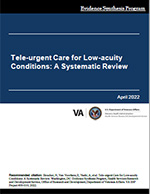
|
Recommended citation: |
Download PDF: Complete Report, Executive Summary, Report, Appendices
Results suggest that the introduction of tele-urgent care may increases system-level healthcare utilization via enhanced access to a convenient source of on-demand care for low-acuity conditions. Of note, evidence was sparse. Further examination is needed to assess whether and how tele-urgent care can be used to improve the health of a population, reduce per capita health care costs, and improve the work life of health care clinical staff.
The VA Office of Connected Care requested this review to identify the current evidence base and the effect of tele-urgent care for low-acuity, nonemergent conditions on key outcomes such as healthcare utilization, patient satisfaction, cost, access, and safety.
We identified 13 studies that evaluated tele-urgent care on key patient and systems-level metrics. Three studies focused on prioritized adverse effects of tele-urgent care ( ie , inappropriate treatment, misdiagnosis, delayed diagnosis, patient deaths, provider burnout). Some limited evidence supports that use of tele-urgent care does not increase subsequent healthcare utilization. Yet, additional evidence suggest that the introduction of tele-urgent care may increase healthcare utilization via enhance access to on-demand care for low acuity conditions. Differences in patient satisfaction did not seem to differ by modality of urgent care (in-person vs. tele-urgent care) or by relationship of clinician providing tele-urgent care to clinic organization (external physicians vs practice-based and/or cooperative physicians). Patients expressed the greatest satisfaction when care they received matched their expectations for care ( eg , receiving in-person care when they expected to receive in-person care). We found no evidence on the impact of tele-urgent care on patient safety or provider burnout.
Tele-urgent Care for Low-acuity Conditions: A Systematic Review (Management Brief)